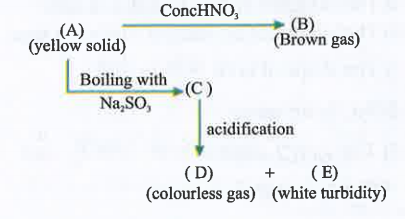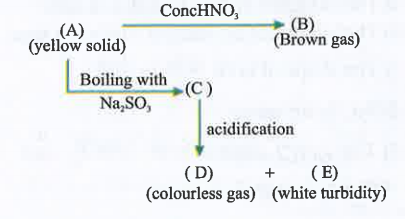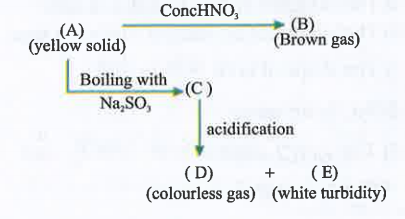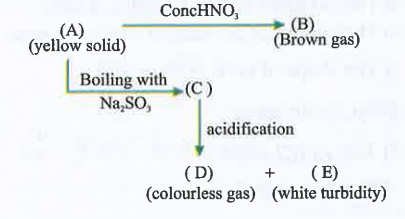Complete Solutions to LEVEL-VI of chapter 16TH GROUP ELEMENTS of Class 12 book with complete answers and questions
| Class 12 | CHEMISTRY |
| Chapter | 16TH GROUP ELEMENTS |
| NARAYANA | LEVEL-VI |
| Number Of Questions | 100 |
| Academic Year | 2023-24 |
Which of the following is incorrect for oxygen
View SolutionI. `H_(2)S` reduces acidified `KMnO_(4)` to `MnSO_(4)`
II. `H_(2)S` reduces acidified `K_(2)Cr_(2)O_(7)` to red colour `Cr_(2)(SO_(4))_(3)`
III. `H_(2)S` reduces nitric acid to `NO_(2)`
IV. `H_(2)S` oxidises ferrous sulphate to ferric sulphate
Then the correct statement(s) is/are:
View Solution`S_(1): 2Se_(2)Cl_(2)rarr SeCl_(4)+3Se`
`S_(2)` : Dioxides like `MnO_(2), PbO_(2)` do not form `H_(2)O_(2)` with dilute acids but they evolve oxygen with concentrated `H_(2)SO_(4)`.
`S_(3)` : Sodium thiosulphate with `FeCl_(3)` solution develops a pink or violet colour which soon vanishes.
`S_(4)` : White precipitate of `PbS_(2)O_(3)` get soluble when boiled with water.
View SolutionWhich of the following acids contain peroxy linkage ?
I. Oleum
II. Marshall's acid
III. Caro's acid
IV. Sulphuric acid
View Solution`H_(2)S` reacts with lead acetate forming black compound which reacts with `O_(3)` to form another compound Y. The colour of the compound Y is:
View SolutionWhich one of the following is incorrect ?
View SolutionWhich of the following is incorrect statement regarding `S_(8)` ?
View SolutionPick out the incorrect statement regarding ozone:
View SolutionThe number of S-S bonds in sulphur trioxide trimer `(S_(3)O_(9))` is
View SolutionA gas 'X' turns lime water milky. The milkiness dissappears if excees of 'X' is passed. Milkiness appears on heating the colourless solution then 'X' is:
View Solution`S_(1):(HPO_(3))_(n)` can be prepared by heating phosphorous acid and bromine in a sealed tube.
`S_(2)` : dry iodine reacts with ozone and formed yellow solid, `I_(4)O_(9)`
`S_(3)` : B sulphur is stable below 369 K.
View SolutionIn the following reaction:
`ZnS+O_(2)overset(Delta)rarrA+ZnO`
`4HCl+O_(2)overset(CuCl_(2))rarrB+2H_(2)O`
`A+B overset(hv)rarrC` Then A, B and C are:
View SolutionA mixture of two gases `AsH_(3)` and `SbH_(3)` is passed through a tube heated at the middle position. Two mirror like depositions are observed of which (I) is before the hot position and (II) is after the hot position. These depositions I and II are of
View SolutionWhen concentrated hypo solution is added to `AgNO_(3)` solution a white ppt is formed. With excees of hypo a complex is formed. The oxidation state and coordination number of central metal ion in the anion are:
View Solution`2S"(fused)" +Cl_(2) rarr A`
`A+H_(2)O rarr HCl+B+C`
A, B and C in the above equations are:
View SolutionWhich of the following compounds can be used for drying of `H_(2)S` gas?
I. Conc `H_(2)SO_(4)`
II. `P_(4)O_(10)`
III. Anhydrous `CaC1_(2)`
IV. Anhydrous `Al_(2)O_(3)`
View Solution`SO_(2)` is a strong reducing agent however it also act as an oxidising agent Which of the following reactions shows its oxidising nature ?
View SolutionWhich of the following statement is incorrect regarding the complete hydrolysis of Marshall's acid ?
View SolutionWhen sulphur is boiled with `Na_(2)SO_(3)` a compound 'A' is produced 'A' with `AgNO_(3)` solution gives unstable white precipitate B, which on standing turns to black C. Compound A, B and C will be respectively:
View Solutionwhich of the following is correct ?
View SolutionIn the given oxides of chromium, the oxide with higher ionic character and the oxide with higher basic nature respectively are:
(i) `CrO`
(ii) `CrO_(3)`
(iii) `Cr_(2)O_(3)`
(iv) `CrO_(2)`
View SolutionWhich of the following option is correctly matched ?
View SolutionIdentify the correct sequence of increasing of `pi-` bonds in the structure of the following molecules `:`
`(I)H_(2)S_(2)O_(6)" "(II)H_(2)S_(2)O_(3)" "(III)H_(2)S_(2)O_(5)`
View SolutionAn inorganic halide `(A)` reacts with water to form two acids `(B)` and `(c). (A)` also reacts with `NaOH` to form two salts `(D)` and `( E)` which remain in solution. The solution gives white precipitate with both `AgNO_3` and `BaCl_2` solutions respectively. `(A)` is a useful organic reagent. Identify `(A)` to `( E)`.
View SolutionSulphur on reaction with concentrated `HNO_3`. Gives `(A)` which reacts with `NaOH` gives `(B).(A)` and `(B)` are
View SolutionWhen an inorganic compound reacts with `SO_2` in aqueous medium produces `(A). (A)` on reaction with `Na_2 CO_3` gives the compound `(B)` which with sulphur gives a substance `(c)` used in photography. The compound `(c)` is.
View SolutionA yellow metallic powder is burnt in a stream of fluorine to obtain a colourless gas X which is thermally stable and chemically inert. Its molecule has octahedral geometry. Another colourless gas Y with same constituent atoms as that of X is obtained when sulphur dichloride is heated with sodium fluoride. Its molecule has trigonal pyramidal structure. X and Y are respectively
View SolutionAn aqueous solution of a gas (X) gives the following reactions :
(i) It decolourizes an acified `K_(2)Cr_(2)O_(7)`.
(ii) On boiling with `H_(2)O_(2)`, cooling it and then adding an aqueous solution of `BaCI_(2)`, a precipitate insoluble in dilute HCI is obtained.
(iii) On passing `H_(2)S` gas in the solution, white turbidity is obtained. identify (X) and give equations for steps (i), (ii) and (iii).
View SolutionComponds `(A)` and `B` are treated with dilute `HCl` separately. The gases liberated are `Y` and `Z` respectively. `Y` turns acidified `K_2 Cr_2 O_7` paper green while `Z` turns lead acetate paper black. The compounds `A` and `B` are respectively :
View SolutionThe correct order of decreasing stability of hexafluorides of group `16` members is
View SolutionWhich of the following statements regarding the manufacture of `H_(2)SO_(4)` by contact process is not true.
View SolutionWhich of the following is incorrect ?
View SolutionA white solid reacts with dilute HCI to give colourless gas that de-colourises aqueous bromine. The solid is likely to be.
View SolutionWhen concentrated sulphuric acid awas treated with potassium ferrocyanide, CO gas was evolved. By mistake, somebody used dilute sulphuric acid instead of concentrated sulphuric acid, then the gas evolved was:
View SolutionIdentify the incorrect statement
View SolutionWhich of the following species has the same number of `X-O-X` linkages, where `X=S` or P?
I. `S_(4)O_(6)^(2-)`
II. `S_(3)O_(9)`
III. `S_(2)O_(5)^(2-)`
IV. `P_(3)O_(9)^(3-)`
View SolutionWhich has the smallest bond angles `(X-S-X)` in the given molecules?
View SolutionChoose correct statement:
View SolutionWhich one of the following does not give tetrathionate as the product, when treated with an aq solution of hypo?
View SolutionA calculated amount of `I_(2)` is used in the preparation of hypo by Spring's reaction because:
View SolutionIdentify the correct statement(s)?
View SolutionWhich one of the following statement(s) is/are correct?
View SolutionWhich of the following order represents correctly according to the property given:
View SolutionWhich one of the following basic radical (s) `is//are ` precipitated as sulphides in acidic medium in qualitative analysis?
View SolutionWhich one of the following statement(s) s/are correct regarding `SO_(2)`?
View SolutionIn which of the following cases, the element is oxidised into its highest oxidation state when it reacted with ozone under moist condition.
View SolutionWhich of the followingg statements are true about sodium thiosulphate, `Na_(2)S_(2)O_(3)`?
View SolutionWhen a compound X reacts with ozone in aq medium, a compound Y is produced. Ozone also reacts with moist Y and produces compound Z. Z acts as an oxidising agent, then X, Y and Z will be:
View SolutionWhich one of the following is/are cannot be hydrolysed?
View SolutionWhich statements are correct for ozone?
View SolutionWhich of the following statements(s) is/are incorrect for `SF_(4)` molecule?
View SolutionWhich of the following statement(s) is/are correct?
View SolutionWhich of the following will not be oxidised by `O_(3)` ?
View SolutionWhich of the following does not give hydrogen peroxide on hydrolysis ?
View SolutionWhich of the following does not have `O-O` linkage but have sulphur-sulphur linkage?
View SolutionWhich of the following compounds can be used for drying of `H_(2)S` gas?
View SolutionWhich of the following statement (s) `is//are` true about ozone?
View SolutionWhich one of the following is/are true for `O_(3)`
View SolutionWhich of the following solution(s) change its colour on passing ozone through it is/are
View SolutionWhich one of the following about `CH_(2)SF_(4)` and `SF_(4)SOF_(4), OCF_(2)` molecules is/are incorrect?
View SolutionSulphur having same oxidation state is:
View SolutionWhich of these statements incorrectly compare between `SF_(4)` and `SF_(6)` ?
View SolutionIn `SOCl_(2)` and `SO_(2)Cl_(2)` which are incorrect
View Solution`FeS+2HCI rarr A+B`(gas)
Gas B is passed into aqueous solution C to form A select the correct statement based on the above facts
View SolutionWhich of the following order represents correctly according to the property given?
View SolutionGas X and Gas Y in solution state react to give a turns substance Z. X has unpleasant odour and turns lead acetate paper black. In the first reaction X is oxidised and Y is reduced. Y on further oxidation with `O_(3)` gives a compound W
X and Y are:
View SolutionGas X and Gas Y in solution state react to give a turns substance Z. X has unpleasant odour and turns lead acetate paper black. In the first reaction X is oxidised and Y is reduced. Y on further oxidation with `O_(3)` gives a compound W
The gas formed when Y reacts with ozone is:
View SolutionGas X and Gas Y in solution state react to give a turns substance Z. X has unpleasant odour and turns lead acetate paper black. In the first reaction X is oxidised and Y is reduced. Y on further oxidation with `O_(3)` gives a compound W
In which of the following reactions also the above turbidity (Z) is seen
View Solution
Yellow solid is :
View Solution
Brown gas B is:
View Solution
C is:
View Solution
Incorrect statement about gas B is
View SolutionSulphur forms hexahalides tetrahalides dihalides and monohalids Sulphur forms only exafluoride but not hexacholorides. Hexabromides and hexaiodes Sulphur halids tend to hydorlyse easily sulphur hexaflouride is an exception of the oxohalids the most important are those of sulphur especially sulphur dichloride oxide (Thoiny chloride) `SO_(2)Cl_(2)` and sulphur dichloride dioxide (sulphuryl chloride) `SO_(2)Cl_(2)` these also hydrolyse in water.
`SF_(6)` do not hydrolyse in water because
View SolutionSulphur forms hexahalides tetrahalides dihalides and monohalids Sulphur forms only exafluoride but not hexacholorides. Hexabromides and hexaiodes Sulphur halids tend to hydorlyse easily sulphur hexaflouride is an exception of the oxohalids the most important are those of sulphur especially sulphur dichloride oxide (Thoiny chloride) `SO_(2)Cl_(2)` and sulphur dichloride dioxide (sulphuryl chloride) `SO_(2)Cl_(2)` these also hydrolyse in water.
Thionyl chloride is dissolved in water. Which of the following statement is wrong about the solution?
View SolutionSulphur forms hexahalides tetrahalides dihalides and monohalids Sulphur forms only exafluoride but not hexacholorides. Hexabromides and hexaiodes Sulphur halids tend to hydorlyse easily sulphur hexaflouride is an exception of the oxohalids the most important are those of sulphur especially sulphur dichloride oxide (Thoiny chloride) `SO_(2)Cl_(2)` and sulphur dichloride dioxide (sulphuryl chloride) `SO_(2)Cl_(2)` these also hydrolyse in water.
Sulphuryl chloride is dissolved in water. which of the following statement is wrong about the solution.
View SolutionMatch the following:

View SolutionMatch the following:

View SolutionMatch the following:

View Solution`Na_(2)S_(2)O_(3)` may react with the compounds given in coloum I. `Na_(2)S_(2)O_(3)` exhibits the properties of the type given in the coloum II, match the reactants given in coloum I with the type of property/properties given in coloum II.
`{:(,"Column I(reactant)",,"Coloumn II(type of property shown)"),("a)",Cl_(2),,"p) complexing agent"),("b)",AgBr,,"q) dispropotionation"),("c)","HCl",,"r) only as reductant"),("d)",I_(2),,"s) an antichlor"):}`
View SolutionMatch the following:
Column I(reaction)
(a) `H_(2)O_(2)+underset("2moles")(ClSO_(3)H) rarr`
(b)`SO_(3)+HClrarr`
c) `SO_(3)+HBr rarr`
(d) `underset(("conc"))(H_(2)SO_(4))+underset"(2moles)"(PCl_(5))rarr`
Column II: P) Halogen is obtained
q) `sp^(3)` hybridisation in any of the product molecules
r) Marshalls acid
s) Sulphuryl chloride
t)Hydrogen halide is obtained as the product.
View SolutionConcentrated `H_(2)SO_(4)` cannot be used to prepare HBr from NaBr , because it ,
View SolutionAssertion: Bleaching action of `SO_(2)` is temporary whereas bleaching action of `Cl_(2)` is permanent.
Reason: Bleaching by `SO_(2)` and `Cl_(2)` is due to oxidation.
View SolutionAsseration: Number of `S-S` bonds in `H_(2)S_(n)O_(6)` is (n-1).
Reason: `H_(2)S_(n)O_(6)` shows `HO_(3)S-underset((n-2))(S)-SO_(3)H`
View SolutionAsseration: `3SnCl_(2)+6HCl+O_(3)rarr3SnCl_(4)+3H_(2)O` is possible reaction showing oxidising nature of `O_(3)`.
Reason: `O_(3)` whenever used as oxidising agent essentially liberates `O_(2)`.
View SolutionAsserarion:Bleaching action action of `SO_(2)` is temporary and by reduction.
Reason: The colour of material is regained due to oxidation by air.
View SolutionAssertion (R) `SF_(6)` is known but `SCl_(6)` is not.
Reason (R) Due to small size of F.
View SolutionAsseration: Cyclic trimer of `SO_(3)` possesses have six membered hetero-cyclic chains made up of `S` and `O`-atoms
Reason: Cyclic trimer of `SO_(3)` is referred as `gamma-SO_(3)`.
View SolutionConsider the following statements,
I. S-S bond is present in `H_(2)S_(2)O_(6).`
II. In peroxodisulphuric acid `(H_(2)S_(2)O_(8))`, sulphur is in `+6` oxidation state.
The correct set of statement is
View SolutionAsseration: The thermal stability of hydrides of oxygen family decrease with molecular weight.
Reason: The decomposition of `M-H` bond requires lesser energy in `O-H` than `S-H`.
View SolutionAssertion (R) `SF_(6)` is known but `SCl_(6)` is not.
Reason (R) Due to small size of F.
View SolutionStatement -1 : Ozone is a powerful oxidising agent in comparison to `O_(2)`.
Statement -1 : `O_(3)` molecules is diamagnetic but `O_(3)^(-)` is paramagnetic.
View SolutionAsseration: `SeCl_(4)`, does not havea tetrahedral structure.
Reason: `Se` in `SeCl_(4)` has two lone pairs.
View SolutionAssertion: `SO_(3)` acts as an oxidising agent as well as a reducing agent
Reason: `SO_(2)` acts as an oxidising as well as a reducing agent
View SolutionAssertion: `H_(2)S_(2)O_(8)` and `H_(2)SO_(5)` act as an oxidising agent while `H_(2)S_(2)O_(3)` can't
Reason: `H_(2)S_(2)O_(8)` and `H_(2)SO_(5)` both have `O-O` bond while in `H_(2)S_(2)O_(3)` molecules `S=O` bond is present
View SolutionStatement -1 : Sodium thiosulphate is not prepared by boiling `Na_(2)SO_(3)` with S in acidic medium.
Statement -2 : `Na_(2)S_(2)O_(3)+H^(+) to 2Na++H_(2)SO_(3)+Sdarr`
View SolutionLet us consider the gases: `H_(2)S,CO_(2)` and `NH_(3)` How many of these gases can be dried by conc `H_(2)SO_(4)` ?
View SolutionOzone reacts with dry iodine to form an oxide having ____oxygen atoms in its molecules.
View SolutionNumber of `sp^(3)` atoms in tetrathionic acid:
View SolutionCompare the following giving reasons Acidic nature of oxides: `CaO, CO, CO_(2),N_(2)O_(5),SO_(3)`
View SolutionAmong the following the number of compounds that can act as dehydrating agent are ……
`Conc. H_(2)SO_(4),"Anhyd". CaCl_(2),Conc. HNO_(3), CaO, CuSO_(4).5H_(2)O, P_(2)O_(5)`
View Solution
LEVEL-VI questions and complete solutions for chapter 16TH GROUP ELEMENTS of NARAYANA CHEMISTRY (HINGLISH) of Class 12